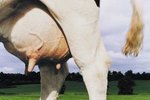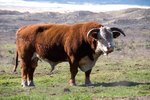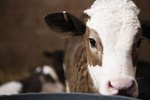
Not many male calves grow up to be bulls. The overwhelming majority of male calves are castrated and sent to market as steers. Those males of exceptionally good quality are left intact to provide sperm for the next generation. Bulls reach sexual maturity before their first birthday.
Puberty
When bulls reach puberty depends on breed and body weight. Bulls are considered to have reached sexual maturity when their ejaculate contains at least 50 million sperm with a 10 percent motility rate. According to the Ontario Ministry of Agriculture and Food, the Brown Swiss bull -- a dairy breed -- reaches puberty at about 264 days old, while the Hereford -- a beef breed -- doesn't hit that mark until day 326. Overall, bulls reach puberty between the ages of 9 and 10 months. About three weeks before reaching puberty, male calves begin showing interest in the opposite sex.
However, just because the bull is capable of breeding before reaching his first birthday doesn't mean it's a good idea. Bulls aged 2 years and up have increased fertility.
Breeding Soundness Examination
At least two months before the start of the breeding season, yearling bulls undergo a breeding soundness examination by a veterinarian. That means most yearling bulls are just that, about the age of 13 months. The vet palpates the reproductive organs, takes a sperm sample for testing and evaluates the condition of the bull's hooves, legs and hips. On a 9-point scale, a yearling bull's body condition score should be about 6, according to Bovine Veterinarian.
Scrotal Circumference
Besides superior genetic qualities, the most important factor when evaluating a young bull for breeding soundness and potential fertility is his scrotal circumference. According to the University of Tennessee Agricultural Extension Service, there's a relationship between scrotal size and early sexual maturity in bulls correlating to positive semen characteristics. These include high percentages of normal, motile sperm and total number of sperm in an ejaculation. In addition, bulls with large scrotums sire heifers who mature sexually earlier than those of bulls with smaller equipment.
Breeding
Depending on the farm or ranch, bulls are either turned out with a cow herd or semen is collected via artificial insemination. Although many commercial cattle operations prefer the 2-year or older bull, a case can be made for the yearling. While the younger bull can't breed with as many cows as the older male, using "virgin" bulls in a breeding program can cut down on bringing disease into the cow herd.
References
- National Center for Biotechnology Information: Sexual Maturation in the Bull
- The Cattle Site: Bull Purchasing and Management
- Bovine Veterinarian: BSEs in Young and Mature Bulls
- University of Tennessee Agricultural Extension Service: Management Of The Beef Bull
- Oklahoma Cooperative Extension Service: Management of Beef Bulls
- Ontario Ministry of Agriculture and Food: Beef Bull Fertility
Photo Credits
-
John Foxx/Stockbyte/Getty Images
Writer Bio
Jane Meggitt has been a writer for more than 20 years. In addition to reporting for a major newspaper chain, she has been published in "Horse News," "Suburban Classic," "Hoof Beats," "Equine Journal" and other publications. She has a Bachelor of Arts in English from New York University and an Associate of Arts from the American Academy of Dramatics Arts, New York City.




